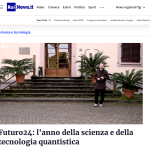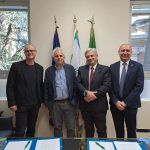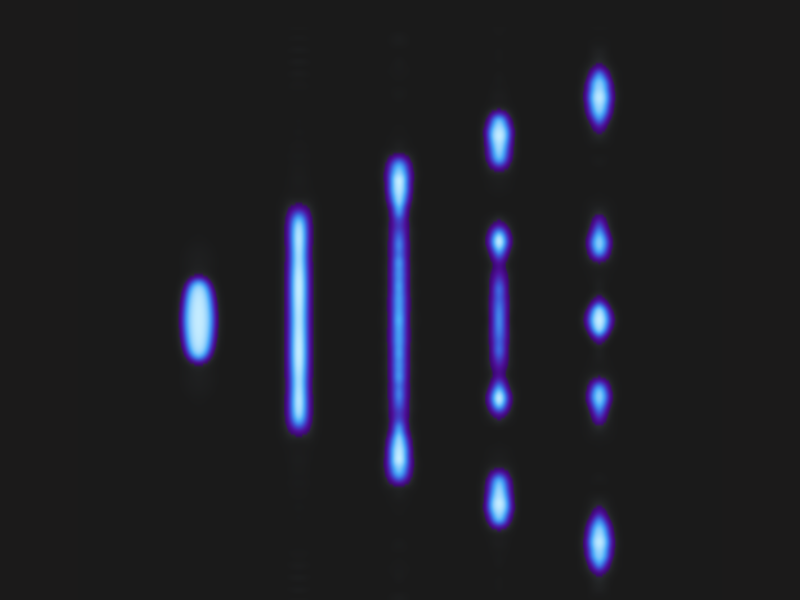
RAI News explores quantum research at CNR-INO: A journey into the future of quantum technologies
March 5, 2025
CNR-INO Signs Strategic Agreement with RSE for Nuclear Fusion Research
March 26, 2025Observation of Quantum Droplet Arrays in Ultracold Atomic Mixtures in Florence
Surface tension drives the breakup of atomic filaments, revealing capillary instability in quantum gases
A team of researchers from the National Research Council of Italy (CNR-INO), the University of Florence, and the European Laboratory for Non-linear Spectroscopy (LENS) has observed the formation of arrays of quantum droplets in ultracold atomic mixtures, a phenomenon driven by surface tension. Much like in classical liquids, surface tension in these systems causes an atomic filament to break into droplets in order to minimize interfacial area. The study, published in Physical Review Letters, represents a significant step forward in the understanding of quantum liquids and in the development of novel atom-based technologies.
The experimental work was carried out at the Quantum Mixtures Laboratory of the National Institute of Optics (CNR-INO) in Florence. Researchers observed capillary instability in a highly unconventional fluid: an ultradilute quantum gas. This discovery has important implications for the understanding and control of novel forms of matter. The study involved collaboration with scientists from the Universities of Bologna, Padua, and the University of the Basque Country (UPV/EHU).
In classical fluid dynamics, surface tension—arising from intermolecular cohesive forces—acts to minimize the interface of a liquid. This mechanism underlies familiar macroscopic phenomena such as the formation of raindrops and soap bubbles. Surface tension is also responsible for the Plateau–Rayleigh instability, in which a narrow liquid jet breaks up into a series of droplets. This instability is a hallmark of liquid behavior and has wide-ranging applications in industry, biomedicine, and nanotechnology.
“In an atomic gas cooled to temperatures near absolute zero, atoms lose their individuality and follow the laws of quantum mechanics. Under certain conditions, these gases, while remaining in the gaseous phase, exhibit liquid-like behavior,” explains the team. Over the past few years, physicists have developed the ability to form quantum droplets from ultracold gases—tiny clusters of atoms stabilized by purely quantum effects that share properties with classical liquids.
The experimental team, led by CNR-INO researcher Alessia Burchianti, used optical imaging and manipulation techniques to investigate the dynamic evolution of a single quantum droplet formed from an ultracold mixture of potassium and rubidium atoms. When released into a laser-generated waveguide, the droplet elongates into a filament, which, upon exceeding a critical length, fragments into smaller droplets. The number of these secondary droplets is proportional to the filament length at the moment of breakup.
“By combining experiments with numerical simulations, we were able to describe the breakup dynamics of a quantum droplet in terms of capillary instability,” says Chiara Fort, a researcher at the University of Florence and a co-author of the study. “While the Plateau–Rayleigh instability is well-known in classical liquids and has also been observed in superfluid helium, it has never before been seen in atomic gases.”
“Our measurements not only advance the understanding of this exotic liquid phase,” adds Luca Cavicchioli, CNR-INO researcher and first author of the paper, “but also demonstrate the possibility of creating quantum droplet arrays for future applications in quantum technologies.”
This research was supported by three initiatives funded by the Italian Ministry of University and Research through the European Union’s NextGenerationEU recovery plan (PNRR – National Recovery and Resilience Plan): the “QUANTAMI” project (PRIN 2022), the “National Quantum Science and Technology Institute” (NQSTI) partnership, and the “Integrated Infrastructure Initiative in Photonic and Quantum Science” (IPHOQS).
Link to the article: https://journals.aps.org/prl/pdf/10.1103/PhysRevLett.134.093401
(Press release published on cnr.it – March 21, 2025)





